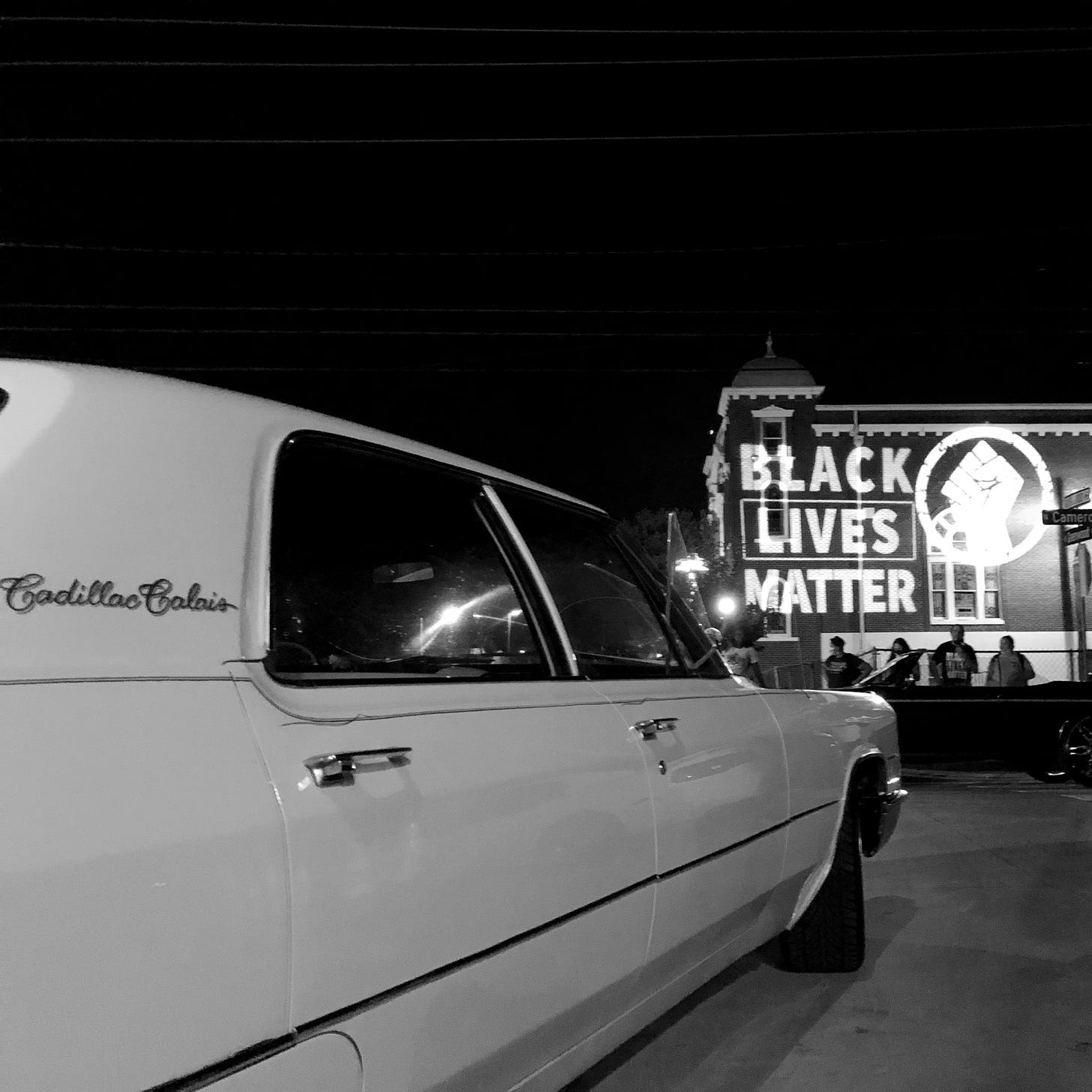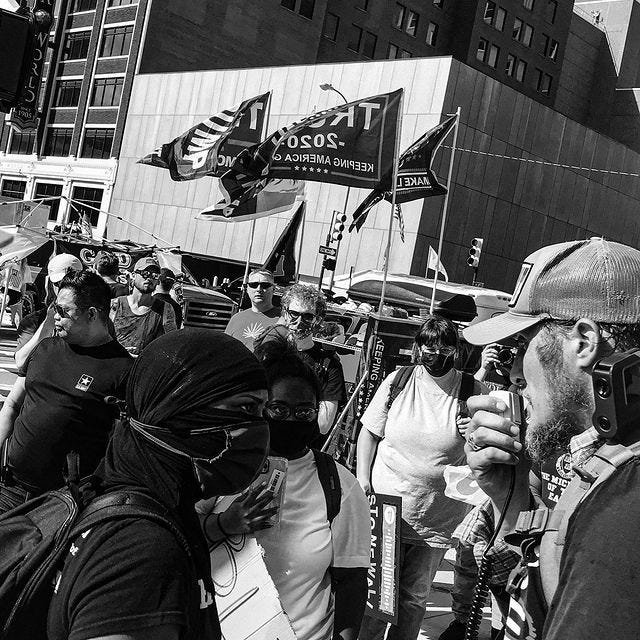The Story of Black Wall Street #012: Black Patriots
What it means to love America as a black person in the days between Juneteenth and the Fourth of July
Welcome to the twelfth edition of Run It Back, my biweekly newsletter about neglected black history. For the foreseeable future the newsletter will be focused on Tulsa’s Black Wall Street, which I’m currently writing a book about for Random House.
Asking a Favor
I spend about 5-10% of my work hours on this newsletter, providing free and documented information about the history of Greenwood and black Oklahoma. I’m trying to build up a large audience for this project to build awareness for my forthcoming book and help myself chart a path of editorial independence that doesn’t leave me tied down to any particular news organization as an exclusive staff writer. I am asking you to share this edition or any previous edition of Run It Back with at least three other people this week and recommend they subscribe. Thanks so much for your continued support. Share and subscribe buttons below.
Your Regularly Scheduled Run It Back
When J.B. Stradford arrived in Washington D.C. on a June morning in 1915, he brought an undeniable optimism about the American experiment. He toured the hospital at Howard University, a feat of black ingenuity that he called “the best equipped and most efficient institution for colored people in the United States.” He visited the White House and the Congressional library. He spoke of his time inside the U.S. Capitol with a clear reverence for the democratic ideals it represented. "Had I the power of language to express the beauty, the sublimity and grandeur of that building, and its arts, I could make you laugh, I could make you weep,” he wrote in a letter home to Oklahoma during the trip.
Stradford, a Greenwood pioneer and prominent Tulsa entrepreneur, was no government sycophant. In 1910, he filed a lawsuit against the Midland Valley Railroad because a railroad conductor tried to force him to move to the Jim Crow car as their train was entering Oklahoma, where segregated rail cars had been enshrined in the constitution. He eventually lost his case in the Oklahoma Supreme Court. In 1916, he protested an ordinance passed by the city of Tulsa that prevented black residents from moving into any city block that was at least 75% white. When Stradford and two other Greenwood leaders brought their grievances to a city council meeting, the mayor and councilors read over bills and answered phone calls while the black men spoke. The measure was upheld. Stradford saw these laws not as slights or inconveniences but as fundamental attacks on his humanity. “To be a man has been my life long desire,” he wrote a few months after his D.C. trip. “To be endowed with all the rights and privileges that any other citizen of this nation has is a question which has agitated the Afro-Americans since the days of reconstruction."
Living in Oklahoma, Stradford observed the core hypocrisies of American dogma laid bare in the starkest terms. If black freedmen sought to assert their rights as citizens via land ownership, they saw their birthrights swindled by deceptive white land grafters. If blacks tried to engage in the democratic process, they faced a Jim Crow caste system more formally rigid than any erected in the South. If they sought economic opportunity through the allegedly benevolent free market, they discovered no amount of wealth could save a black body from cataclysmic racial violence. They were denied those freedoms that we as a people are taught to be thankful for every 4th of July.
But they were still Tulsans, Oklahomans, and Americans. At dance halls on Greenwood Avenue, they hosted bittersweet sendoffs for their boys who were drafted to fight in World War I, and would one day return from Europe as men who could no longer countenance the indignity of Jim Crow. They sang the “Star Spangled Banner” and “Glory, Glory, Hallelujah” in the streets outside the Greenwood dance halls in an effort to “sing and win the war.” They acknowledged July 4th, but they really celebrated on Juneteenth, when it was their freedom and their ongoing struggles that took center stage.
The residents of Greenwood bore the burden of living in two Americas at once, the idealized version imagined in the minds of white slaveholders in 1776, and the more brutal reality that they and their ancestors paid witness to long before and after that year. Their very names often carried the weight of this contradiction. A.J. Smitherman, the editor of the black newspaper the Tulsa Star, was named after President Andrew Jackson. He could articulate better than most what it meant to be a patriot living outside the prescribed boundaries of patriotism:. “[The American Negro] is not a real part and parcel of the great American family. Like a bastard child he is cast off, he is subjected to injustice and insult, he is given only the menial tasks to perform. He is not wanted but is needed. He is both used and abused. He is in the land of the free but is not free. He is despised and rejected [by] his brothers in white. But he is an American nevertheless.”

Tulsa’s 2020 Juneteenth celebration was called “I, Too, Am America,” a reference to the famous Langston Huges poem. It was organized quickly in opposition to Donald Trump’s planned rally in Tulsa on June 19. It was, in its own way, a peacekeeping mission--black Tulsa leaders emphasized again and again that they wanted people to stay in Greenwood and not feed any flames of hate that Trump might try to stoke.
For outsiders it might be hard to grasp just how close Greenwood is to downtown Tulsa and the site of the Trump rally. Though my assignment for the weekend was to cover the Greenwood side of things, I and a photographer I was working with for The New Yorker, Derico Green, made the brief mile-long walk to the B.O.K. Arena to see the Trump world with our own eyes. We walked past boarded-up ATM machines and building facades that had been painted over with messages like “Love Trumps Hate.” “Fuck Donald Trump” by YG and Nipsey Hussle was being played so often it sounded as if it was echoing through the downtown streets.
Closer to the arena, a street lined on both sides by Trump tailgate tents had been blocked off by concrete barriers. I can only describe it as a kind of “Trump bazaar” where his loudest and most argumentative supporters were reveling in their First Amendment rights. A large group of anti-Trump protesters dressed in all black, led by a young black woman wielding a bullhorn, marched through the space chanting “No Trump, No Pence!” They eventually squared off against a group of Trump supporters, led by an older white man carrying a Trump-Pence flag. The mass of people lurched to and fro around the narrow street, traveling in circles since the barriers made it impossible to fan out. Within the tight confines of the area, there was not even physical space for a neutral observer, let alone rhetorical space.
Tulsa’s establishment has spent the last several years trying to carve out a neutral path forward. They’ve replaced streets named after overt racists like Tate Brady, a former Ku Klux Klan member, with soothing phrases like “Reconciliation Way.” A massive, mostly privately funded park in midtown Tulsa is called “The Gathering Place” and billed as a place of community healing, though it mostly serves white residents.
But the compounding stressors of COVID-19, the killing of George Floyd, and Trump’s surprise rally exposed fault lines here that no clever labeling could mend. Juneteenth weekend was cathartic because it pushed these labels in a more direct and courageous direction--“Black Lives Matter” was painted on the asphalt of Greenwood Avenue, fluttering on a banner in front of the convention hall where blacks were detained after the massacre, and projected onto the side of a Greenwood church--but we don’t yet know whether policies that materially improve black lives will follow the feel-good rhetoric. What’s different right now, at least, is that the pretense that the argument over how to chart the future of America will happen on white people’s terms has evaporated.
The most striking image of the weekend for me was the Black Wall Street memorial on Greenwood Avenue covered in a blue tarp. The memorial is a glistening slab of black marble that features a list of businesses destroyed in the massacre and a poem called “O Greenwood!” by a massacre survivor named Wynonia Murray Bailey. It’s a somber monument in a somber place. It should not be an object of voracious consumption. When it was rumored that Mike Pence would make a visit to Greenwood on Saturday, Tulsans covered the memorial to deprive the vice president of an easy photo op.
“After you create legislation, we’ll welcome you to Greenwood because you’ve honored the ancestors,” said Greg Robinson, a mayoral candidate and director of family and community engagement at a North Tulsa nonprofit called the Met Cares Foundation. “But until then it’s disrespectful to allow you to trod on their graves. This is a holy land.” He was showing the same reverence for Black Wall Street that one of the community’s founders had shown for the powerful symbols of democracy in the nation’s capital.
America certainly doesn’t deserve black patriots, given all that has happened in the weeks, months, years, decades, centuries that predate this moment. We are born into a psychologically destructive paradox--“He is in the land of the free but is not free”--while our fellow white citizens are nurtured in a cocoon of passive indifference. And yet both groups are expected to show the same respect to the flag, the state, and the electoral process. We are watching this core hypocrisy be rejected by citizens en masse in unpredictable ways that seem unprecedented in recent memory, but make more sense when you extend your lens across the arc of our nation’s history. Here in America, gross injustice is often resolved through spasms of violence.
What we as a nation must resist is the desire to smother the black patriot in the redemptive arc of the white one. Black people have been loudly protesting life inside the paradox for centuries--it was white people, in their comfortable cocoons, who ignored it. If now is truly a moment of foundational change in the United States, let no one claim the country is moving in a bold new progressive direction. We will only be making good on the demands J.B. Stradford and millions of others sought from their home country generations ago. These are the things Stradord said he wanted: “Freedom of thought, freedom of speech, freedom of press, freedom of locomotion, and freedom to act as you please so long as you do not abridge the rights of others. This is the freedom which is delegated to the white man in Oklahoma, and denied to the black man. What can I do, in Oklahoma, that my life long hope may be realized?”
Sources
'“‘I Helped Elect You and You Asked Me to Do It,’ Negro Boss Tells the Mayor—But Simmons Heard Him Not.” Tulsa Democrat. Aug. 8 1916.
“My Life’s Ambition.” Tulsa Star. Oct. 16 1915.
“Soldier Boys Get Big Send Off.” Tulsa Star. May 4 1918.
“Stradford Continues Journey Through East.” Tulsa Star. June 26 1915.
Stratford vs. Midland Valley Railroad Company. Archives and Records, Oklahoma Department of Libraries.
Tulsa Star. Aug. 31 1918.



